|
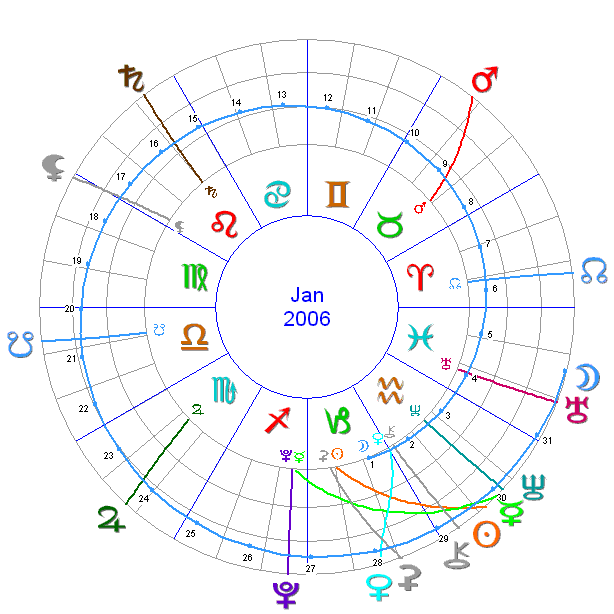

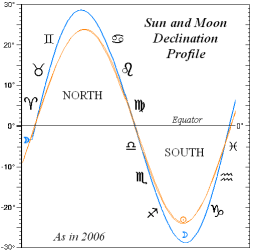
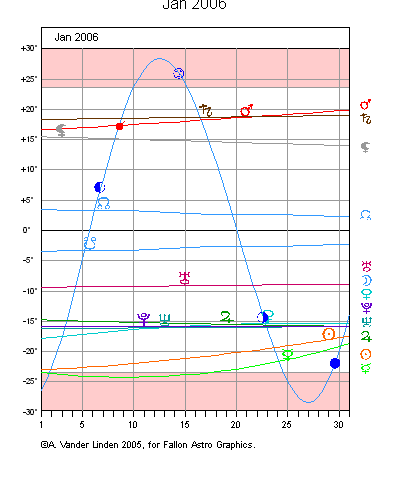
The 1st column is for the Moon longitude at midnight (0:00). And each day has an empty line for you to jot down notes.
The table lists all the conjunctions including their longitudes, their declination, and distance apart # in declination, plus description notes (see below).
The table also includes the 4 Moon Phases, the crossing of its Nodes, plus the Moon Apogee and Perigee,
The apogee and perigee are the points in the Moon’s orbit farthest and nearest the Earth.
The apogee (True Black Moon or Lilith) is the second focus of the elliptical Moon’s orbit around the Earth (the Earth being the other focus).
The orbital speed is greatest and the pull stronger at perigee.
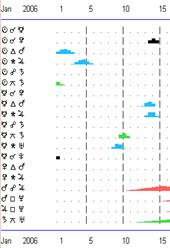
|
Circular Longitudes (monthly pages)
The circular charts show planets moving in longitude from the 1st of the month (from the centre) to the last day (outwards).
In the annual chart -on the cover and page 4-, the same principle applies : from the 1st to the last day of the year.
To allow precision in time and space, in the background, a grey grid divides the month
in 3 x 10 days, and each zodiac sign in 3 decans of 10°. In the annual chart, the year is divided in it’s 4 quarters of 3 months each.
Lunation Charts
The New and Full Moon charts are important because they belong to bigger mundane cycles. The orbs of the aspects drawn on the charts are limited to 4°. Aries right orientated charts are used to visually match the synchronous declinations and the Universal zodiac.
The 4 Moon phases also appear on the monthly declination graph. Find the New and Full Moon list in page 5.
Stations
This box list when planets change their apparent direction, Direct or Retrograde.
Daily Ephemeris
Below the charts, stands the daily ephemeris of the planets longitudes and of the Sideral Time at Midnight GMT. Also included : the True Lunar Node -hinge with the ecliptic-, the True Lilith (Dark or Black Moon : the Moon is precisely conjunct the True Black Moon when at Apogee) ; plus asteroid Ceres and planetoid Chiron.
Ingress Table
Ingress Times, indicate when bodies enter a new Sign. This allows to know when the Moon is no more void-of-course.
When a planet ingress occurs Retrograde -entering a sign at 29°59’59”-, it is noticed by a little “r “.
Declination Matters
Declination, the 3rd dimension of our charts, measures the distance the planet has with the celestial Equator (0° N/S). The year starts on the left side of the graph and time moves towards the right.
The graph shows the relationship between longitude and declination for the ecliptic, the Sun path. When declination moves North, the diurnal arc increases. This rule is also valid for the Moon and the planets.
Declination Diagram
We can see how the graph is related to the Circular Longitudes : as the 0° line of declination is the Equator itself, we also have the Equator located on a longitude chart -between 0° Aries and 0° Libra-. This works perfectly for the Sun crossing the 4 seasons at the 4 cardinal points when at equinoxes or solstices. It only varies a bit for the other bodies -in relation to their celestial latitude-.
The rose areas -top and bottom of the graph- show when the bodies are Out-of-Bounds -OOB- , or outside the ecliptics limits: more than 23°26’ North or South.
A planet’s declination reflects its position in the zodiac -except for Pluto-. It also tells us about the duration of its presence / absence above the horizon every day. Or which Earth latitudes sees that planet culminating perfectly on its Zenith -as 25°N for Miami or Luxor-.
The sinusoid of the Moon’s declination ascends between Capricorn and Cancer -or between Sagittarius and Gemini-, until it reaches it’s Maximum at standstill, called Lunistice. The Moon then descends between Cancer and Capricorn -or Gemini and Sagittarius- until its minimum. The Lunistice standstills are at the top and bottom sides of the Moon’s Cross †, the horizontal part being the Equator’s crossings.
Calendar table
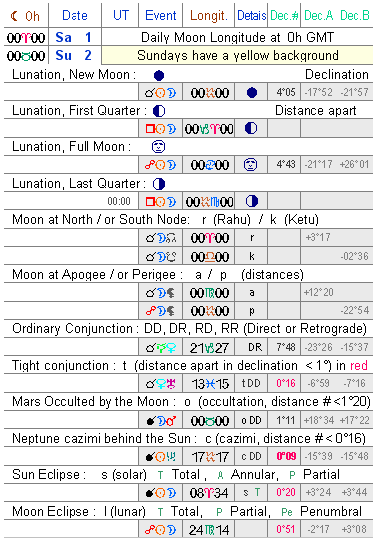
Major Aspects
Here also the month starts on the left and ends on the right side of the graph. The table shows the aspects between all the planets in transit, but the Moon. Base for election astrology, as well as for Mundane forecasts.
Compared with an ordinary aspect list, this one gathers their duration in time, as well as their type by the colours, and their synchronicity.
The table shows the aspects between all the planets in transit, but the Moon. Base for election astrology, as well as for Mundane forecasts.
Declination Aspects
The table lists the major parallels // and contra-parallels # between planets from Mars to Pluto (grey background). Parallels occur North (+) or South (-), and # are noted in absolute value.
Then all the crossings of Equator, and the Maxima and minima for the Moon (Lunistice) and the planets (yellow background).
Out-of-Bound : when the Moon or a Planet’s declination goes beyond 23°26’27” North or South.
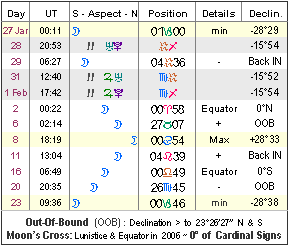
Left: body at South standstill, declination minima (m).
Center Left: enters or quits the South OOB Zone.
Centre: crosses the Equator
Centre Right: enters or quits the North OOB Zone.
Right: body at North standstill, declination Maxima (M).
The other parallels are simply visible on the graph. Find the other declination aspects to the rapid planets in the Raphael or in the Rosicrucian Ephemeris.
Astro-Mapping (cartography)
p. 30 -> 40
Parans show the latitudes on Earth where planets are on two angles, AS, MC, DS or IC, simultaneously.
Basic Ephemeris :
p. 41
Global views : p. 42 & 43
Longitude graph -360° of the Zodiac on a vertical rule- and declination graphs for 2006 compared with the period 2000-2010.
Heliocentric Data p. 44& 45
Wheel charts (5) for the 1st day of each quarter as well as a longitude graph help to figure out the basic helio motions.
A table lists the major heliocentric aspects between the slow planets, and when planets cross their Nodes, Aphelia and Perihelia.
Now that you've read this page, just relax… and enjoy the voyage through the solar system !
Rainbow Ephemeris Intro
© Astrid Fallon, 2002-2006. All rights reserved.
|







